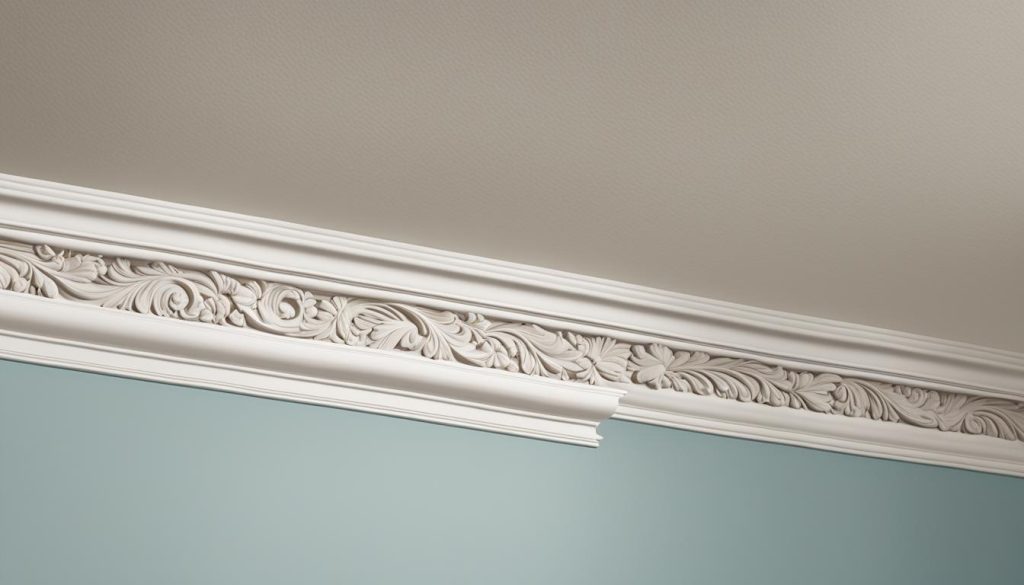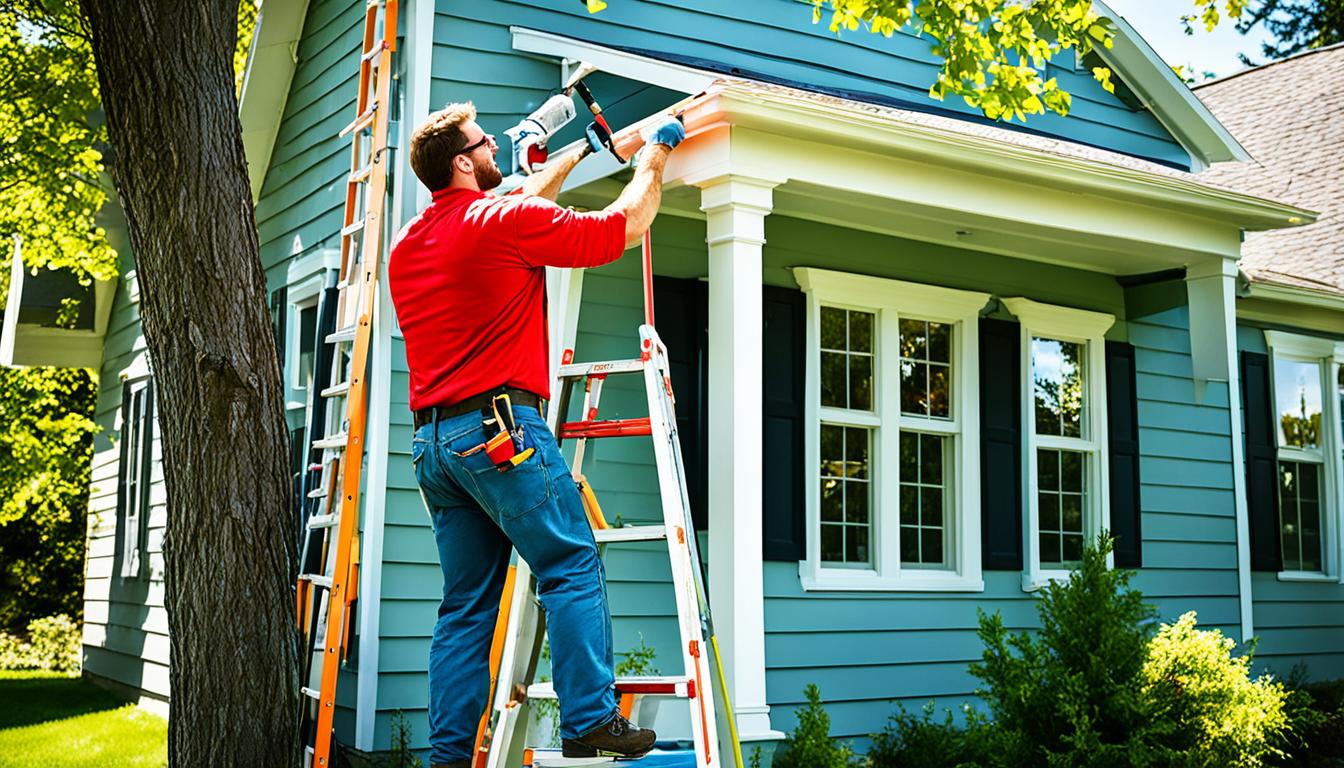Did you know that the cost to paint interior and exterior trim ranges from $1 to $6 per linear foot on average? That’s right! According to HomeAdvisor, homeowners can transform the look of their homes at a surprisingly affordable price. Whether you’re looking to refresh your interior trim or give your exterior a facelift, professional painters offer competitive rates that make it accessible to everyone.
Key Takeaways:
- Professional painters provide affordable rates for exterior trim painting.
- The average cost to paint interior trim is $500 to $1,500 for a standard 1,500-square-foot home.
- The cost to paint exterior trim ranges from $1,000 to $2,500 for the same size home.
- Using an exterior trim painting cost calculator can help estimate the project cost.
- Hiring a professional ensures high-quality results and saves homeowners time and effort.
Cost to Paint Trim Per Linear Foot
When it comes to painting the trim of your home, understanding the cost per linear foot is essential. Knowing this information can help you budget for your painting project and avoid any surprises along the way.
The average cost to paint trim is between $1 and $6 per linear foot. However, keep in mind that this is just a general range, and the final price may vary based on several factors:
- The size of your home: A larger home will generally have more linear footage of trim, which can increase the overall cost.
- The type of trim: Different types of trim may require different preparation techniques or additional coats of paint, affecting the total cost.
- Hard-to-reach areas: Trim located in difficult-to-access spots, such as high ceilings or tight corners, may require extra time and effort, resulting in higher labor costs.
- Extensive prep work: If your trim has extensive damage or requires extensive sanding, caulking, or priming, it may increase the overall cost of the project.
To get a more accurate estimate of the cost to paint trim per linear foot for your specific home, you can utilize an exterior trim painting cost calculator. These online tools take into account the linear footage of your trim and other relevant factors to provide you with a more precise cost estimate.
By understanding the cost to paint trim per linear foot and utilizing helpful tools like a cost calculator, you can better plan for your painting project and ensure that you stay within your budget.
| Type of Trim | Cost per Linear Foot |
|---|---|
| Baseboards | $1 – $4 |
| Window Trim | $2 – $6 |
| Door Trim | $3 – $5 |
| Crown Molding | $4 – $8 |
Cost to Paint Exterior Trim
When it comes to painting the exterior trim of your home, several factors can influence the overall cost. These factors include the type of paint required, the accessibility of high areas, and the specific preparation requirements. It’s essential to consider these factors when estimating the cost and hiring a professional painter.
In terms of materials, exterior paint typically ranges from $20 to $80 per gallon. However, keep in mind that the quantity of paint needed will depend on the size of your trim project. Additionally, professional painters may charge higher fees for more complex or hard-to-reach areas, such as second-floor trim or intricate designs.
The cost to paint exterior trim can vary depending on the specific elements that need to be painted. This includes eaves, fascia, soffits, doors, windows, dormers, and gables. Each of these elements may have different sizes, difficulty levels, and specific needs that can affect the overall cost.
| Exterior Trim Element | Estimated Cost |
|---|---|
| Eaves | $XXX – $XXX |
| Fascia | $XXX – $XXX |
| Soffits | $XXX – $XXX |
| Doors | $XXX – $XXX |
| Windows | $XXX – $XXX |
| Dormers | $XXX – $XXX |
| Gables | $XXX – $XXX |
These estimated costs are subject to variations based on the size, intricacy, and specific requirements of each element. It’s always best to consult with a professional painter for an accurate estimate tailored to your home’s exterior trim painting project.
Interior Trim Painting Prices
When it comes to giving your home’s interior a fresh look, repainting the trim can make a big difference. But how much does it cost to paint the interior trim? Let’s break it down.
The average cost for repainting all the interior trim of a standard home typically ranges from $500 to $1,500. Keep in mind that this is an average estimate and the final cost may vary depending on several factors.
If you have a larger home or you prefer high-end paint, the cost may be higher. Additional factors that can influence the cost include the linear footage of the trim, the height of the ceilings, and the condition of the surfaces.
Common interior trim elements that require professional painting include crown molding, baseboards, doors, and windows. These areas often require meticulous attention to detail, and hiring a professional painter ensures a high-quality finish.

When calculating the cost, consider the complexity and size of your home’s interior trim. It’s also important to factor in any repair work or surface preparation that may be required.
Ultimately, investing in professional interior trim painting not only enhances the overall appearance of your home but also saves you time and effort. Look for local painters who can provide detailed estimates tailored to your specific project needs.
Next, we’ll explore the labor costs involved in painting trim and highlight the advantages of hiring professionals for the job.
Labor Costs to Paint Trim
When it comes to painting trim, labor costs are an important consideration for homeowners. Hiring a professional painter can ensure a high-quality finish and save both time and effort. Let’s take a closer look at the average labor costs for interior and exterior trim painting.
Professional painters typically charge an hourly rate or a flat fee for their services. The average labor cost for painting interior and exterior trim ranges from $20 to $75 per hour. However, it’s important to note that the exact cost may vary depending on various factors.
The total labor time required for a trim painting project depends on factors such as prep work, access to the trim, the size of the trim, and the number of coats needed. Larger areas or complex trim designs may require more time and effort to complete.
It’s also worth mentioning that different painters may have different pricing structures, so it’s always a good idea to obtain multiple quotes and compare them to find the best option for your specific needs. Additionally, be sure to discuss the details of the project with the painter to ensure they understand your expectations and scope of work.
Benefits of Hiring a Professional Painter
- Expertise and Experience: Professional painters have the necessary expertise and experience to handle trim painting projects efficiently and effectively.
- Time Savings: Hiring a professional allows homeowners to focus on other tasks while the experts take care of the trim painting.
- Quality Results: Professional painters have the knowledge and skills to deliver a high-quality finish, ensuring that the trim looks beautiful and lasts longer.
Now that we’ve explored the labor costs associated with painting trim and the benefits of hiring a professional, let’s move on to the next section to learn more about the DIY option and how it compares to hiring a professional.

| Trim Type | Labor Cost Range per Hour |
|---|---|
| Interior Trim | $20 – $75 |
| Exterior Trim | $20 – $75 |
DIY vs. Professional
When it comes to painting exterior trim, homeowners often find themselves debating whether to tackle the project themselves or hire a professional painter. While a DIY approach may seem cost-effective initially, there are several advantages to hiring a professional that should be considered.
Time and Effort: Painting exterior trim requires significant prep work, including cleaning, sanding, and priming. By hiring a professional, you can save valuable time and energy, allowing you to focus on other tasks or enjoy your free time.
Specialized Tools and Materials: Professionals have access to high-quality tools and materials specifically designed for the job. They can ensure that the right products are used for long-lasting and durable results.
Experience and Expertise: Professional painters have years of experience and expertise in handling various trim types, surfaces, and architectural features. They know the right techniques to achieve a flawless finish and can navigate any challenges that may arise during the process.
Cost-effective Solutions: While hiring a professional painter may seem expensive at first, it can actually save you money in the long run. Professionals have access to paint deals and can advise you on cost-effective solutions for your specific trim painting needs.
Excellent Results: Professional painters take pride in their work and strive to deliver excellent results. They have the skills and knowledge to transform your exterior trim, enhancing the overall appearance and curb appeal of your home.
DIY vs. Professional: A Comparison
| DIY | Professional | |
|---|---|---|
| Time and Effort | Requires significant time and effort to complete the project | Saves time and effort for homeowners |
| Tools and Materials | May require purchasing or renting specialized tools and materials | Professionals have access to high-quality tools and materials |
| Experience and Expertise | Relies on DIY skills and may lack professional expertise | Professionals have years of experience and expertise |
| Cost-effective Solutions | Potential for mistakes and costly rework | Professionals provide cost-effective solutions and access to paint deals |
| Results | May result in inconsistent or amateur-looking finish | Delivers excellent and professional-looking results |
Tips for Painting Trim
When it comes to painting trim, proper preparation is the key to a successful project. Here are some helpful tips to ensure a smooth and professional-looking finish:
- Gather the necessary supplies: Before you start painting, make sure you have all the essential tools and materials. This includes the right sheen paint for trim, primer for new wood, caulk for repairs, thin detailing brushes, sandpaper, painter’s tape, and drop cloths.
- Sand the surfaces: Use sandpaper to smooth out any rough areas on the trim. This will help the paint adhere better and result in a smoother finish.
- Apply primer: If you’re working with new wood or repairing damaged areas, apply a coat of primer before painting. This will ensure better coverage and durability.
- Paint from top to bottom: Start painting from the top of the trim and work your way down. This will help prevent drips and ensure a neat and even finish.
- Protect surrounding areas: Use painter’s tape to mask off any areas that you don’t want to be painted, such as windows or walls. It’s also a good idea to cover the floor and furniture with drop cloths to protect them from paint splatters.
- Remove old caulk if needed: If there is old or cracked caulk on the trim, remove it before painting. This will create a clean and seamless look once the painting is complete.
By following these tips, you can achieve professional-looking results and enhance the appearance of your home’s trim. So, gather your supplies, prepare the surfaces, and get ready to transform your trim with a fresh coat of paint!
How Much Paint Do You Need?
When it comes to painting your exterior trim, it’s crucial to determine how much paint you’ll need for the job. The amount of paint required depends on the linear footage and width of the trim. To calculate this accurately, homeowners can make use of an exterior trim painting cost calculator, which takes into account the specific dimensions of the trim.
It’s important to note that each gallon of paint typically covers an area of 350 to 400 square feet. By inputting the linear footage and width of the trim into the cost calculator, you can easily determine the amount of paint needed for your project. This ensures that you purchase the right quantity and avoid any excess or shortage.
Before using the exterior trim painting cost calculator, measure the width of the trim and convert it to linear feet if necessary. This information will provide accurate calculations and help you plan your budget accordingly. By knowing how much paint is needed in advance, you can streamline your painting project and prevent any delays or additional expenses.
